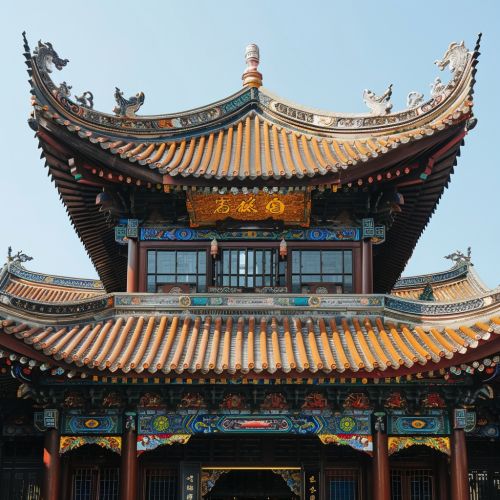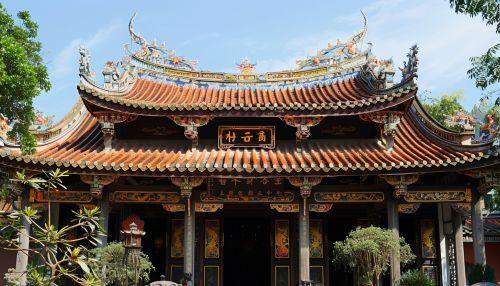Chinese Architecture: Difference between revisions
(Created page with "== Overview == Chinese architecture is a style of architecture that has taken shape in East Asia over many centuries. It encompasses a variety of structures, including palaces, temples, pagodas, and residential buildings, each reflecting the social, cultural, and historical contexts of their times. This article delves into the intricate details and evolution of Chinese architecture, exploring its unique characteristics, historical development, and cultural significance....") |
No edit summary |
||
| Line 112: | Line 112: | ||
* [[Wang Shu]] | * [[Wang Shu]] | ||
[[Image:Detail-93083.jpg|thumb|center|Traditional Chinese temple with ornate roof and decorative elements.|class=only_on_mobile]] | |||
[[Image:Detail-93084.jpg|thumb|center|Traditional Chinese temple with ornate roof and decorative elements.|class=only_on_desktop]] | |||
== Categories == | == Categories == | ||
Latest revision as of 23:15, 21 June 2024
Overview
Chinese architecture is a style of architecture that has taken shape in East Asia over many centuries. It encompasses a variety of structures, including palaces, temples, pagodas, and residential buildings, each reflecting the social, cultural, and historical contexts of their times. This article delves into the intricate details and evolution of Chinese architecture, exploring its unique characteristics, historical development, and cultural significance.
Historical Development
Prehistoric and Ancient China
Chinese architecture traces its origins back to the Neolithic period, with evidence of early structures such as pit houses and wooden frameworks. The Yangshao culture (5000–3000 BCE) and the Longshan culture (3000–2000 BCE) provide some of the earliest examples of Chinese architectural practices. These early structures were primarily made of wood and earth, reflecting the abundant natural resources available.
Zhou Dynasty (1046–256 BCE)
During the Zhou Dynasty, Chinese architecture began to take on more defined characteristics. The use of timber framing became more sophisticated, and the concept of the courtyard house emerged. This period also saw the construction of large-scale public buildings and palaces, often aligned with cardinal directions and following strict geomantic principles.
Qin and Han Dynasties (221 BCE–220 CE)
The Qin Dynasty (221–206 BCE) marked significant advancements in Chinese architecture, including the construction of the Great Wall of China. The subsequent Han Dynasty (206 BCE–220 CE) saw further development in urban planning and the use of brick and tile in construction. Han architecture is characterized by its grandiose palaces, elaborate tombs, and the introduction of the dougong (bracket system), which became a defining feature of traditional Chinese architecture.
Tang and Song Dynasties (618–1279)
The Tang Dynasty (618–907) is often considered a golden age of Chinese architecture, with the construction of monumental structures such as the Giant Wild Goose Pagoda and the Tang Palace. The Song Dynasty (960–1279) continued this architectural flourishing, with advancements in building techniques and the widespread use of the jian (modular unit) in residential and public buildings.
Yuan, Ming, and Qing Dynasties (1271–1912)
The Yuan Dynasty (1271–1368) introduced new architectural influences from the Mongol Empire, while the Ming Dynasty (1368–1644) is renowned for its construction of the Forbidden City and the restoration of the Great Wall. The Qing Dynasty (1644–1912) saw the culmination of traditional Chinese architectural styles, with the construction of elaborate gardens, temples, and palaces, such as the Summer Palace and the Temple of Heaven.
Architectural Elements
Timber Framing
Timber framing is a hallmark of traditional Chinese architecture. The use of wood allows for flexibility and resilience in construction, particularly in earthquake-prone regions. The dougong system, a complex network of wooden brackets, supports the roof and distributes weight evenly, enabling the construction of large, open interior spaces.
Roof Structures
Chinese roofs are distinctive for their sweeping curves and upturned eaves. These roofs are often adorned with intricate carvings and glazed tiles. The hip-and-gable roof (xie shan) is a common style, characterized by a combination of sloping and vertical sections. The double-eave roof is another notable feature, often seen in imperial buildings and temples.
Courtyard Layout
The siheyuan (courtyard house) is a traditional residential design that features a central courtyard surrounded by buildings on all four sides. This layout promotes natural ventilation and lighting, while also providing privacy and security. The courtyard house is a microcosm of Chinese cosmology, reflecting principles of harmony and balance.
Decorative Elements
Chinese architecture is rich in decorative elements, including intricate woodwork, stone carvings, and painted murals. These decorations often feature motifs such as dragons, phoenixes, and other auspicious symbols. The use of color is also significant, with red symbolizing good fortune and yellow reserved for imperial structures.
Cultural Significance
Feng Shui
Feng Shui (wind and water) is an ancient Chinese practice that influences architectural design. It involves the arrangement of buildings and spaces to harmonize with the natural environment and promote positive energy flow. Key principles of Feng Shui include the orientation of buildings, the placement of doors and windows, and the use of natural elements.
Symbolism
Chinese architecture is imbued with symbolism, reflecting cultural beliefs and values. For example, the use of dragons and phoenixes in decoration symbolizes power and prosperity. The orientation and layout of buildings often follow cosmological principles, aligning with cardinal directions and celestial bodies.
Religious and Philosophical Influences
Buddhism, Daoism, and Confucianism have all left their mark on Chinese architecture. Buddhist temples, such as the Shaolin Temple, feature pagodas and statues that reflect Buddhist teachings. Daoist temples, like the White Cloud Temple, incorporate natural elements and emphasize harmony with the environment. Confucian architecture, exemplified by the Confucius Temple, focuses on simplicity and order.
Regional Variations
Northern China
Northern Chinese architecture is characterized by its use of brick and stone, reflecting the harsher climate and availability of materials. The Great Wall and the Forbidden City are prime examples of northern architectural styles, featuring massive walls, imposing gates, and intricate detailing.
Southern China
Southern Chinese architecture, in contrast, often utilizes wood and bamboo, materials that are more abundant in the region. The Tulou (earthen buildings) of Fujian province are unique circular structures that provide communal living spaces and defense. The Lingnan architecture of Guangdong province is known for its open courtyards, decorative tiles, and intricate woodwork.
Western China
Western Chinese architecture reflects the diverse cultural influences of the region. The Mogao Caves in Dunhuang, for example, are a series of Buddhist cave temples that feature elaborate murals and sculptures. The Tibetan architecture of the region incorporates elements of Indian and Nepalese styles, with structures such as the Potala Palace showcasing multi-story buildings and flat roofs.
Modern Chinese Architecture
Early 20th Century
The early 20th century saw the introduction of Western architectural styles to China, leading to a fusion of traditional and modern elements. The Republic of China period (1912–1949) witnessed the construction of buildings that combined classical Chinese motifs with Western techniques, such as the Sun Yat-sen Mausoleum.
Post-1949 Developments
Following the establishment of the People's Republic of China in 1949, architecture in China underwent significant changes. The emphasis shifted towards functional and utilitarian designs, with the construction of large-scale public housing and industrial buildings. The Great Hall of the People in Beijing is a notable example of this period, combining monumental scale with socialist realism.
Contemporary Trends
In recent decades, Chinese architecture has experienced a renaissance, with a renewed interest in traditional styles and the incorporation of cutting-edge technology. Iconic structures such as the National Centre for the Performing Arts and the Shanghai Tower exemplify this blend of tradition and modernity. Contemporary Chinese architects, such as Wang Shu and Ma Yansong, are gaining international recognition for their innovative designs that respect cultural heritage while embracing modernity.
Preservation and Challenges
Conservation Efforts
Preserving China's architectural heritage is a complex and ongoing challenge. Many ancient structures are at risk due to urbanization, environmental factors, and neglect. Efforts to conserve and restore historical buildings are being undertaken by both governmental and non-governmental organizations. Notable projects include the restoration of the Forbidden City and the preservation of traditional Hutongs in Beijing.
Urbanization and Modernization
Rapid urbanization and modernization pose significant challenges to the preservation of traditional Chinese architecture. The demand for new infrastructure and housing often leads to the demolition of historical buildings. Balancing development with conservation requires careful planning and a commitment to protecting cultural heritage.
Legal and Policy Framework
China has implemented various laws and policies to protect its architectural heritage. The Cultural Relics Protection Law and the establishment of the State Administration of Cultural Heritage are key components of this framework. These measures aim to regulate construction activities, promote conservation, and raise public awareness about the importance of preserving historical sites.
See Also
- Great Wall of China
- Forbidden City
- Feng Shui
- Shaolin Temple
- Tulou
- Mogao Caves
- Potala Palace
- National Centre for the Performing Arts
- Shanghai Tower
- Wang Shu


